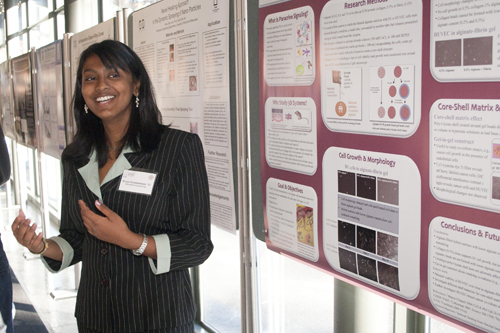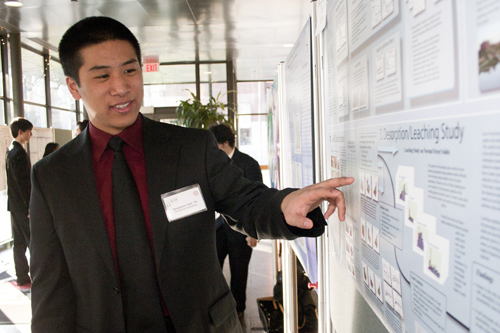News
Harvard College students flocked to the Maxwell Dworkin lobby on Thursday for the fifth annual Harvard Undergraduate Research Symposium (HURS).
Hosted by the Harvard College Undergraduate Research Association (HCURA), the event highlighted student research and exposed interested undergraduates to a wealth of opportunities across the sciences. It also provided a forum for students to meet with members of the faculty to discuss their ideas and receive guidance for ongoing projects.
“You work on your one little topic, and sometimes your struggles are so narrow,” says Charles Liu ’11, president of HCURA. “It’s good to be able to see what other people are doing.”
Over 50 students were selected to display posters, and six students who have completed outstanding research were chosen as plenary speakers. Ellen Farber ’13, who studies computer science at the School of Engineering and Applied Sciences (SEAS), spoke about her experience developing a robot that can collect sensory data and process it onboard before transmitting information to a remote computer.
David Edwards, who is a Professor of the Practice of Biomedical Engineering at SEAS and a core member of the Wyss Institute for Biologically Inspired Engineering, gave the keynote address.
For many undergraduates, participating in research can be the experience that cements their interests and aspirations.
Janet Song ’13, the special events co-chair for HURS and a board member for HCURA, got involved in research in her first year at Harvard. She explored molecular and cellular biology, hoping to contribute to the early detection of cancer. Now, with a clearer sense of her interests, she studies neurobiology and stem cells.
“I want to go to grad school, work in academia, and do what my PI is doing now,” she says with confidence.
“Working in the lab has helped me in the classroom, and vice versa,” she says, but the most satisfying part of the undergraduate research experience for her has been “asking a question no one knows the answer to.”

Suvai Gunasekaran ’13 (above) knows that cancer cells sometimes proliferate when they are surrounded by certain types of other cells—but she doesn’t know why.
She wants to find out what type of chemical signaling mechanism between the cells is telling them to grow, so she has created a system that helps to identify the molecules passing in and out of the cells.
Using tissue engineering techniques that she’s learning in the lab of her adviser, David Mooney, Robert P. Pinkas Family Professor of Bioengineering, Gunasekaran encapsulates individual cells in layers of alginate gel. She can vary the properties of the layers, restricting the size of the molecules that can pass through. The new technique should help her to identify which chemical signals are encouraging the cancer to grow.
Like most of the research taking place at SEAS, Gunasekaran’s project requires a certain amount of interdisciplinary collaboration.
“When I make the gel, I have to work with people who are familiar with the material,” she explains. “On the other side, we have to make sure that we know whether the cells are viable and whether they’re growing. And we have to know what they like to grow in. It always seems to require a compromise between having viable cells and stable materials.”
Gunasekaran began her research in the Mooney lab last year and was able to continue to work over the summer, thanks to a Herchel Smith Fellowship.
“I really enjoy the research aspect of science,” she says. “I want to continue doing that.”

Benjamen Sun ’14 (above) presented research he has been pursuing since the seventh grade. Growing up in Grand Forks, North Dakota, he saw that the United States Geological Survey periodically analyzed local water samples, but the results were not published very often. He wanted to know how the water quality was changing, and how much the city was contributing to pollution.
Exploring his interests, he eventually discovered that sand and dust on the city streets were picking up heavy metal pollutants and carrying them to the river, potentially harming biological systems downstream.
“It opened my eyes to the world of research,” he says.
Sun has always seemed to know just what he wanted to do. In elementary school, when he was asked to write a letter to his future self—a senior in high school—he told himself to apply to Harvard.
Now that he’s actually here, facing the task of picking a concentration, he cannot decide between chemistry, physics, biology, or biomedical engineering. That might not be a problem, though.
“I wanted to come to a place where everything is really good,” he says. “If I went to MIT and decided I didn’t want to do science anymore, I wouldn’t be in the right place.”
SEAS undergraduates who are interested in locating research opportunities will find helpful resources on the Undergraduate Research page and through the Harvard College Office of Undergraduate Research Initiatives.
To see more photos of the event, visit the SEAS Communications Office’s Flickr site.
Cutting-edge science delivered direct to your inbox.
Join the Harvard SEAS mailing list.
